Samsung's Business Environment: An Internal & External Analysis
VerifiedAdded on 2023/04/20
|15
|4236
|119
Report
AI Summary
This report presents a comprehensive internal and external environmental analysis of Samsung, a global conglomerate based in South Korea. It begins with an introduction to Samsung's generic business strategy, highlighting its mixed approach of differentiation and cost leadership. The internal analysis delves into Samsung's values, company culture, organizational divisions, structure, and value chain activities, including inbound logistics, operations, outbound logistics, marketing and sales, and service. The external analysis utilizes PEST (Political, Economic, Social, Technological) factors to assess the macro-environmental influences, followed by a SWOT analysis identifying Samsung's strengths, weaknesses, opportunities, and threats. Porter’s Five Forces analysis evaluates the competitive intensity of the industry, considering the threat of new entrants and substitutes, the bargaining power of suppliers and buyers, and the rivalry among existing competitors. The report concludes by summarizing the key influences and strategic implications derived from the analysis.
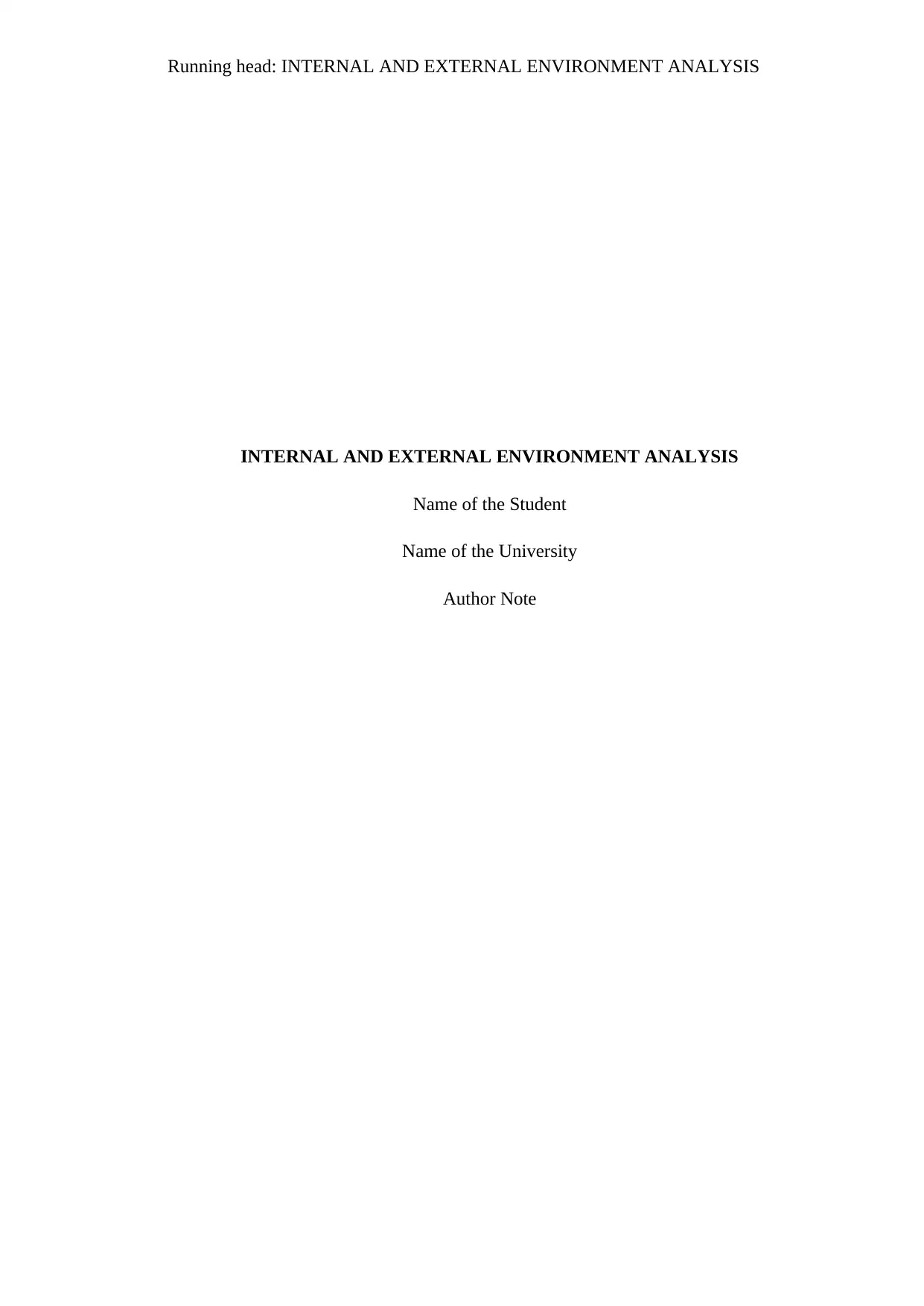
Running head: INTERNAL AND EXTERNAL ENVIRONMENT ANALYSIS
INTERNAL AND EXTERNAL ENVIRONMENT ANALYSIS
Name of the Student
Name of the University
Author Note
INTERNAL AND EXTERNAL ENVIRONMENT ANALYSIS
Name of the Student
Name of the University
Author Note
Paraphrase This Document
Need a fresh take? Get an instant paraphrase of this document with our AI Paraphraser
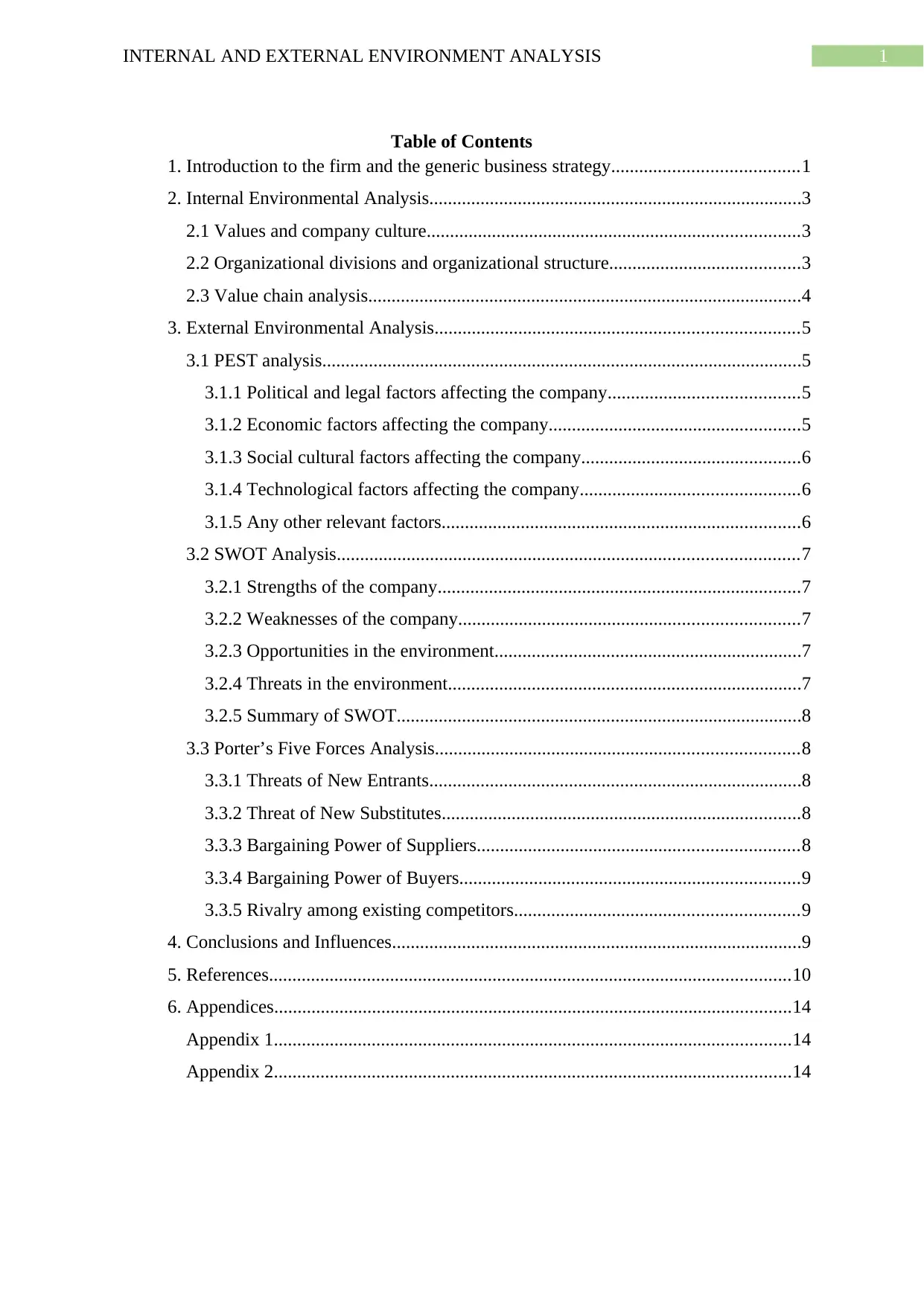
1INTERNAL AND EXTERNAL ENVIRONMENT ANALYSIS
Table of Contents
1. Introduction to the firm and the generic business strategy........................................1
2. Internal Environmental Analysis................................................................................3
2.1 Values and company culture................................................................................3
2.2 Organizational divisions and organizational structure.........................................3
2.3 Value chain analysis.............................................................................................4
3. External Environmental Analysis..............................................................................5
3.1 PEST analysis.......................................................................................................5
3.1.1 Political and legal factors affecting the company.........................................5
3.1.2 Economic factors affecting the company......................................................5
3.1.3 Social cultural factors affecting the company...............................................6
3.1.4 Technological factors affecting the company...............................................6
3.1.5 Any other relevant factors.............................................................................6
3.2 SWOT Analysis...................................................................................................7
3.2.1 Strengths of the company..............................................................................7
3.2.2 Weaknesses of the company.........................................................................7
3.2.3 Opportunities in the environment..................................................................7
3.2.4 Threats in the environment............................................................................7
3.2.5 Summary of SWOT.......................................................................................8
3.3 Porter’s Five Forces Analysis..............................................................................8
3.3.1 Threats of New Entrants................................................................................8
3.3.2 Threat of New Substitutes.............................................................................8
3.3.3 Bargaining Power of Suppliers.....................................................................8
3.3.4 Bargaining Power of Buyers.........................................................................9
3.3.5 Rivalry among existing competitors.............................................................9
4. Conclusions and Influences........................................................................................9
5. References................................................................................................................10
6. Appendices...............................................................................................................14
Appendix 1...............................................................................................................14
Appendix 2...............................................................................................................14
Table of Contents
1. Introduction to the firm and the generic business strategy........................................1
2. Internal Environmental Analysis................................................................................3
2.1 Values and company culture................................................................................3
2.2 Organizational divisions and organizational structure.........................................3
2.3 Value chain analysis.............................................................................................4
3. External Environmental Analysis..............................................................................5
3.1 PEST analysis.......................................................................................................5
3.1.1 Political and legal factors affecting the company.........................................5
3.1.2 Economic factors affecting the company......................................................5
3.1.3 Social cultural factors affecting the company...............................................6
3.1.4 Technological factors affecting the company...............................................6
3.1.5 Any other relevant factors.............................................................................6
3.2 SWOT Analysis...................................................................................................7
3.2.1 Strengths of the company..............................................................................7
3.2.2 Weaknesses of the company.........................................................................7
3.2.3 Opportunities in the environment..................................................................7
3.2.4 Threats in the environment............................................................................7
3.2.5 Summary of SWOT.......................................................................................8
3.3 Porter’s Five Forces Analysis..............................................................................8
3.3.1 Threats of New Entrants................................................................................8
3.3.2 Threat of New Substitutes.............................................................................8
3.3.3 Bargaining Power of Suppliers.....................................................................8
3.3.4 Bargaining Power of Buyers.........................................................................9
3.3.5 Rivalry among existing competitors.............................................................9
4. Conclusions and Influences........................................................................................9
5. References................................................................................................................10
6. Appendices...............................................................................................................14
Appendix 1...............................................................................................................14
Appendix 2...............................................................................................................14
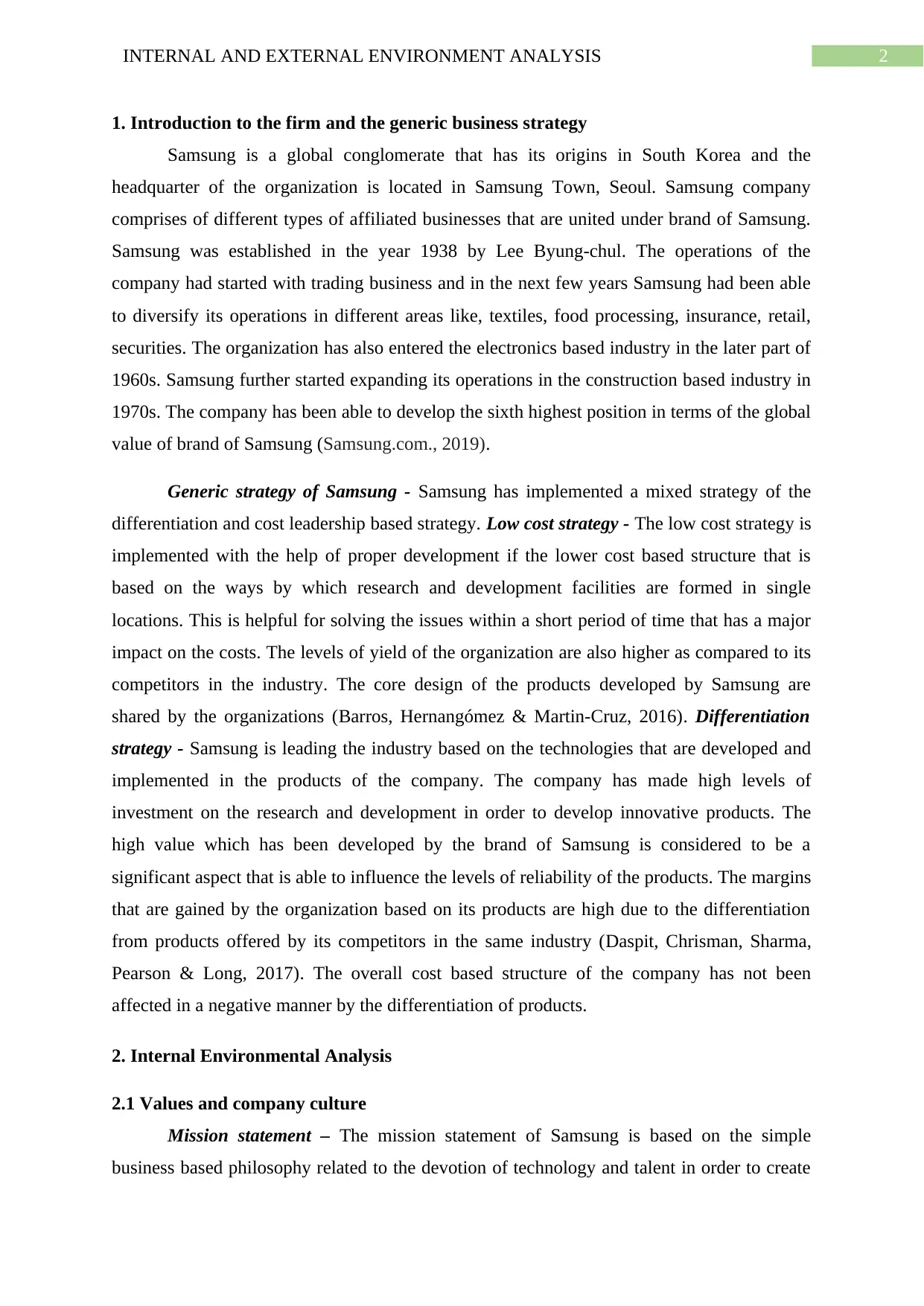
2INTERNAL AND EXTERNAL ENVIRONMENT ANALYSIS
1. Introduction to the firm and the generic business strategy
Samsung is a global conglomerate that has its origins in South Korea and the
headquarter of the organization is located in Samsung Town, Seoul. Samsung company
comprises of different types of affiliated businesses that are united under brand of Samsung.
Samsung was established in the year 1938 by Lee Byung-chul. The operations of the
company had started with trading business and in the next few years Samsung had been able
to diversify its operations in different areas like, textiles, food processing, insurance, retail,
securities. The organization has also entered the electronics based industry in the later part of
1960s. Samsung further started expanding its operations in the construction based industry in
1970s. The company has been able to develop the sixth highest position in terms of the global
value of brand of Samsung (Samsung.com., 2019).
Generic strategy of Samsung - Samsung has implemented a mixed strategy of the
differentiation and cost leadership based strategy. Low cost strategy - The low cost strategy is
implemented with the help of proper development if the lower cost based structure that is
based on the ways by which research and development facilities are formed in single
locations. This is helpful for solving the issues within a short period of time that has a major
impact on the costs. The levels of yield of the organization are also higher as compared to its
competitors in the industry. The core design of the products developed by Samsung are
shared by the organizations (Barros, Hernangómez & Martin-Cruz, 2016). Differentiation
strategy - Samsung is leading the industry based on the technologies that are developed and
implemented in the products of the company. The company has made high levels of
investment on the research and development in order to develop innovative products. The
high value which has been developed by the brand of Samsung is considered to be a
significant aspect that is able to influence the levels of reliability of the products. The margins
that are gained by the organization based on its products are high due to the differentiation
from products offered by its competitors in the same industry (Daspit, Chrisman, Sharma,
Pearson & Long, 2017). The overall cost based structure of the company has not been
affected in a negative manner by the differentiation of products.
2. Internal Environmental Analysis
2.1 Values and company culture
Mission statement – The mission statement of Samsung is based on the simple
business based philosophy related to the devotion of technology and talent in order to create
1. Introduction to the firm and the generic business strategy
Samsung is a global conglomerate that has its origins in South Korea and the
headquarter of the organization is located in Samsung Town, Seoul. Samsung company
comprises of different types of affiliated businesses that are united under brand of Samsung.
Samsung was established in the year 1938 by Lee Byung-chul. The operations of the
company had started with trading business and in the next few years Samsung had been able
to diversify its operations in different areas like, textiles, food processing, insurance, retail,
securities. The organization has also entered the electronics based industry in the later part of
1960s. Samsung further started expanding its operations in the construction based industry in
1970s. The company has been able to develop the sixth highest position in terms of the global
value of brand of Samsung (Samsung.com., 2019).
Generic strategy of Samsung - Samsung has implemented a mixed strategy of the
differentiation and cost leadership based strategy. Low cost strategy - The low cost strategy is
implemented with the help of proper development if the lower cost based structure that is
based on the ways by which research and development facilities are formed in single
locations. This is helpful for solving the issues within a short period of time that has a major
impact on the costs. The levels of yield of the organization are also higher as compared to its
competitors in the industry. The core design of the products developed by Samsung are
shared by the organizations (Barros, Hernangómez & Martin-Cruz, 2016). Differentiation
strategy - Samsung is leading the industry based on the technologies that are developed and
implemented in the products of the company. The company has made high levels of
investment on the research and development in order to develop innovative products. The
high value which has been developed by the brand of Samsung is considered to be a
significant aspect that is able to influence the levels of reliability of the products. The margins
that are gained by the organization based on its products are high due to the differentiation
from products offered by its competitors in the same industry (Daspit, Chrisman, Sharma,
Pearson & Long, 2017). The overall cost based structure of the company has not been
affected in a negative manner by the differentiation of products.
2. Internal Environmental Analysis
2.1 Values and company culture
Mission statement – The mission statement of Samsung is based on the simple
business based philosophy related to the devotion of technology and talent in order to create
⊘ This is a preview!⊘
Do you want full access?
Subscribe today to unlock all pages.

Trusted by 1+ million students worldwide
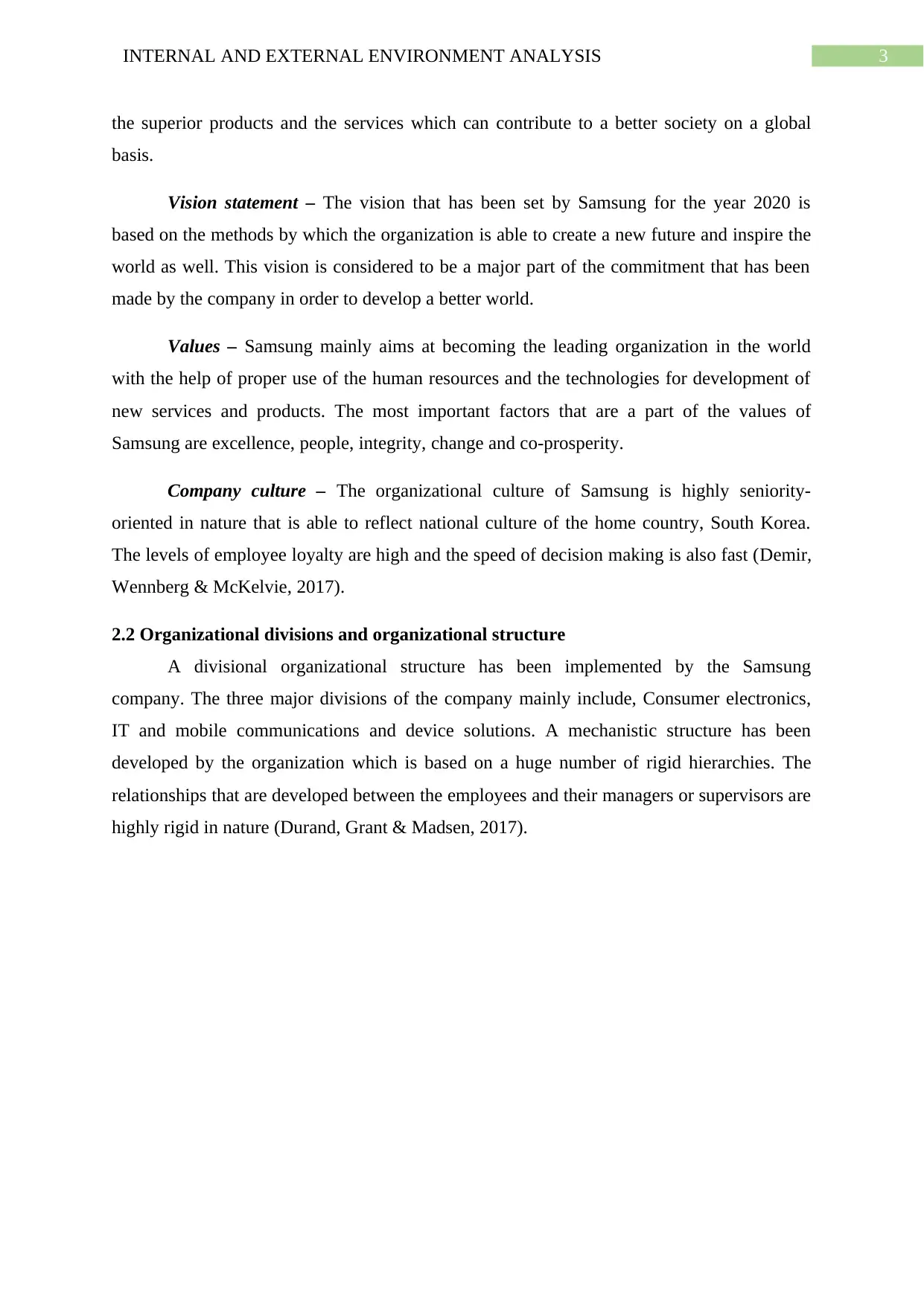
3INTERNAL AND EXTERNAL ENVIRONMENT ANALYSIS
the superior products and the services which can contribute to a better society on a global
basis.
Vision statement – The vision that has been set by Samsung for the year 2020 is
based on the methods by which the organization is able to create a new future and inspire the
world as well. This vision is considered to be a major part of the commitment that has been
made by the company in order to develop a better world.
Values – Samsung mainly aims at becoming the leading organization in the world
with the help of proper use of the human resources and the technologies for development of
new services and products. The most important factors that are a part of the values of
Samsung are excellence, people, integrity, change and co-prosperity.
Company culture – The organizational culture of Samsung is highly seniority-
oriented in nature that is able to reflect national culture of the home country, South Korea.
The levels of employee loyalty are high and the speed of decision making is also fast (Demir,
Wennberg & McKelvie, 2017).
2.2 Organizational divisions and organizational structure
A divisional organizational structure has been implemented by the Samsung
company. The three major divisions of the company mainly include, Consumer electronics,
IT and mobile communications and device solutions. A mechanistic structure has been
developed by the organization which is based on a huge number of rigid hierarchies. The
relationships that are developed between the employees and their managers or supervisors are
highly rigid in nature (Durand, Grant & Madsen, 2017).
the superior products and the services which can contribute to a better society on a global
basis.
Vision statement – The vision that has been set by Samsung for the year 2020 is
based on the methods by which the organization is able to create a new future and inspire the
world as well. This vision is considered to be a major part of the commitment that has been
made by the company in order to develop a better world.
Values – Samsung mainly aims at becoming the leading organization in the world
with the help of proper use of the human resources and the technologies for development of
new services and products. The most important factors that are a part of the values of
Samsung are excellence, people, integrity, change and co-prosperity.
Company culture – The organizational culture of Samsung is highly seniority-
oriented in nature that is able to reflect national culture of the home country, South Korea.
The levels of employee loyalty are high and the speed of decision making is also fast (Demir,
Wennberg & McKelvie, 2017).
2.2 Organizational divisions and organizational structure
A divisional organizational structure has been implemented by the Samsung
company. The three major divisions of the company mainly include, Consumer electronics,
IT and mobile communications and device solutions. A mechanistic structure has been
developed by the organization which is based on a huge number of rigid hierarchies. The
relationships that are developed between the employees and their managers or supervisors are
highly rigid in nature (Durand, Grant & Madsen, 2017).
Paraphrase This Document
Need a fresh take? Get an instant paraphrase of this document with our AI Paraphraser
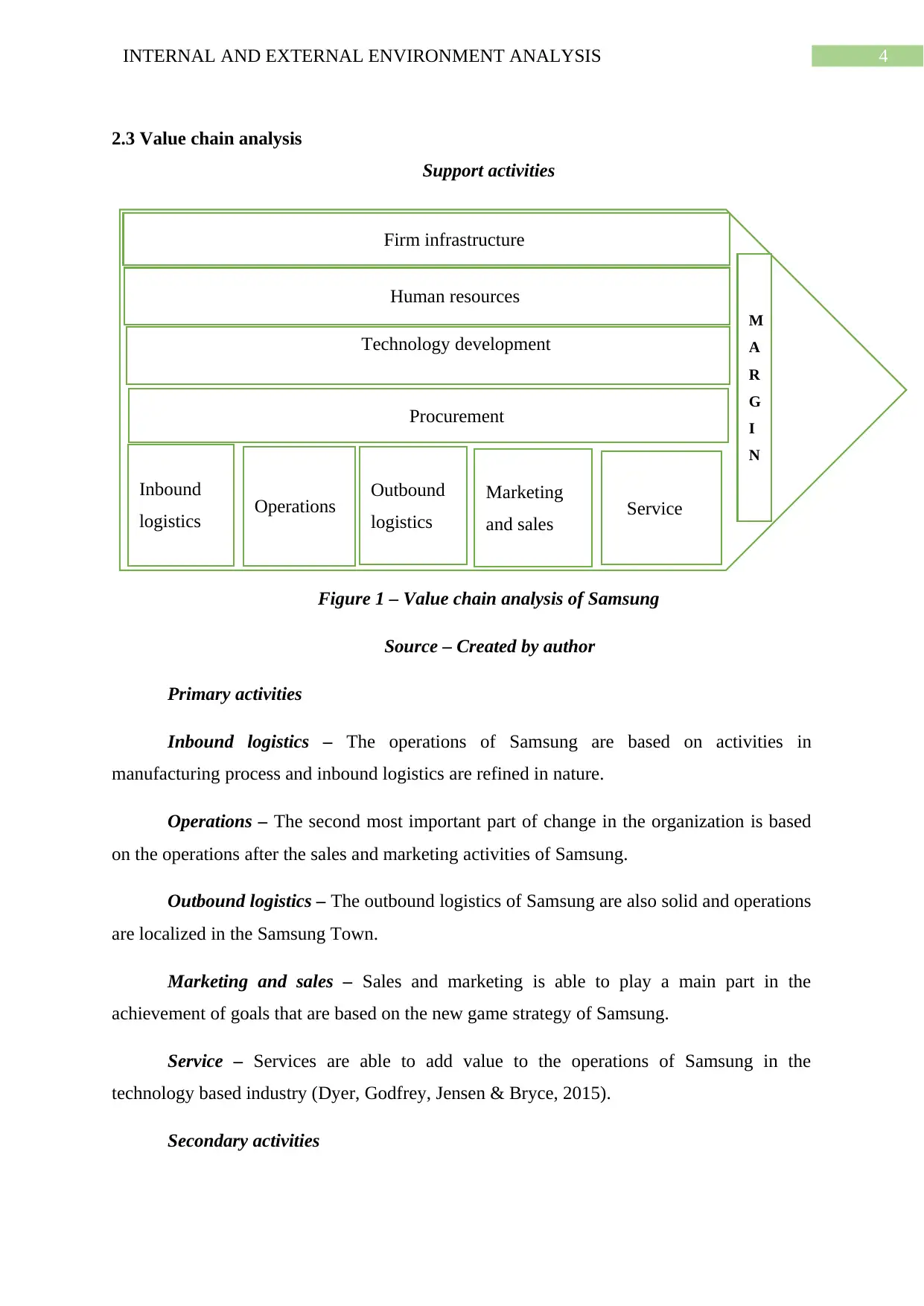
4INTERNAL AND EXTERNAL ENVIRONMENT ANALYSIS
2.3 Value chain analysis
Support activities
Primary activities
Figure 1 – Value chain analysis of Samsung
Source – Created by author
Primary activities
Inbound logistics – The operations of Samsung are based on activities in
manufacturing process and inbound logistics are refined in nature.
Operations – The second most important part of change in the organization is based
on the operations after the sales and marketing activities of Samsung.
Outbound logistics – The outbound logistics of Samsung are also solid and operations
are localized in the Samsung Town.
Marketing and sales – Sales and marketing is able to play a main part in the
achievement of goals that are based on the new game strategy of Samsung.
Service – Services are able to add value to the operations of Samsung in the
technology based industry (Dyer, Godfrey, Jensen & Bryce, 2015).
Secondary activities
Firm infrastructure
Human resources
Technology development
Procurement
Inbound
logistics Operations Outbound
logistics
Marketing
and sales Service
M
A
R
G
I
N
2.3 Value chain analysis
Support activities
Primary activities
Figure 1 – Value chain analysis of Samsung
Source – Created by author
Primary activities
Inbound logistics – The operations of Samsung are based on activities in
manufacturing process and inbound logistics are refined in nature.
Operations – The second most important part of change in the organization is based
on the operations after the sales and marketing activities of Samsung.
Outbound logistics – The outbound logistics of Samsung are also solid and operations
are localized in the Samsung Town.
Marketing and sales – Sales and marketing is able to play a main part in the
achievement of goals that are based on the new game strategy of Samsung.
Service – Services are able to add value to the operations of Samsung in the
technology based industry (Dyer, Godfrey, Jensen & Bryce, 2015).
Secondary activities
Firm infrastructure
Human resources
Technology development
Procurement
Inbound
logistics Operations Outbound
logistics
Marketing
and sales Service
M
A
R
G
I
N
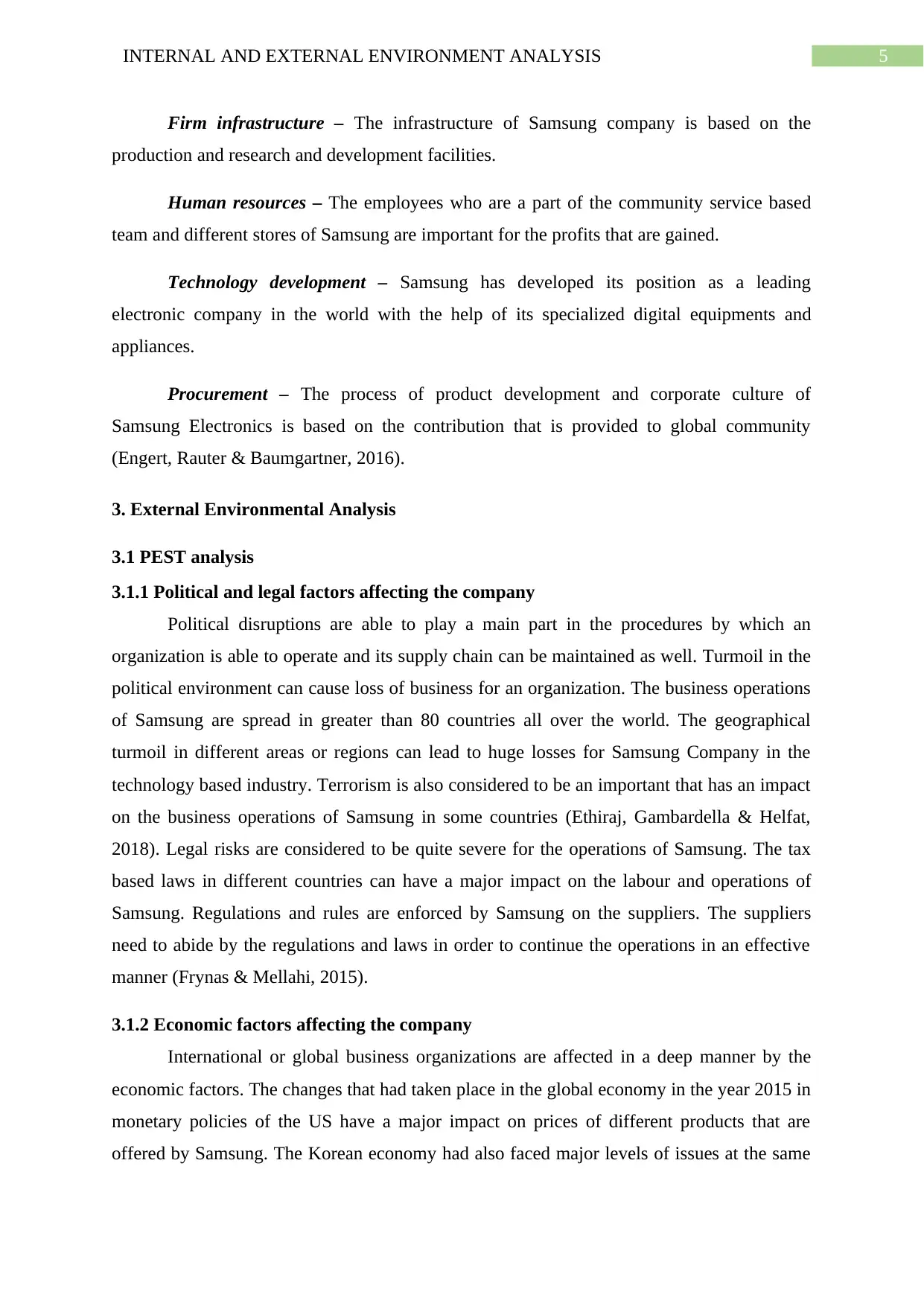
5INTERNAL AND EXTERNAL ENVIRONMENT ANALYSIS
Firm infrastructure – The infrastructure of Samsung company is based on the
production and research and development facilities.
Human resources – The employees who are a part of the community service based
team and different stores of Samsung are important for the profits that are gained.
Technology development – Samsung has developed its position as a leading
electronic company in the world with the help of its specialized digital equipments and
appliances.
Procurement – The process of product development and corporate culture of
Samsung Electronics is based on the contribution that is provided to global community
(Engert, Rauter & Baumgartner, 2016).
3. External Environmental Analysis
3.1 PEST analysis
3.1.1 Political and legal factors affecting the company
Political disruptions are able to play a main part in the procedures by which an
organization is able to operate and its supply chain can be maintained as well. Turmoil in the
political environment can cause loss of business for an organization. The business operations
of Samsung are spread in greater than 80 countries all over the world. The geographical
turmoil in different areas or regions can lead to huge losses for Samsung Company in the
technology based industry. Terrorism is also considered to be an important that has an impact
on the business operations of Samsung in some countries (Ethiraj, Gambardella & Helfat,
2018). Legal risks are considered to be quite severe for the operations of Samsung. The tax
based laws in different countries can have a major impact on the labour and operations of
Samsung. Regulations and rules are enforced by Samsung on the suppliers. The suppliers
need to abide by the regulations and laws in order to continue the operations in an effective
manner (Frynas & Mellahi, 2015).
3.1.2 Economic factors affecting the company
International or global business organizations are affected in a deep manner by the
economic factors. The changes that had taken place in the global economy in the year 2015 in
monetary policies of the US have a major impact on prices of different products that are
offered by Samsung. The Korean economy had also faced major levels of issues at the same
Firm infrastructure – The infrastructure of Samsung company is based on the
production and research and development facilities.
Human resources – The employees who are a part of the community service based
team and different stores of Samsung are important for the profits that are gained.
Technology development – Samsung has developed its position as a leading
electronic company in the world with the help of its specialized digital equipments and
appliances.
Procurement – The process of product development and corporate culture of
Samsung Electronics is based on the contribution that is provided to global community
(Engert, Rauter & Baumgartner, 2016).
3. External Environmental Analysis
3.1 PEST analysis
3.1.1 Political and legal factors affecting the company
Political disruptions are able to play a main part in the procedures by which an
organization is able to operate and its supply chain can be maintained as well. Turmoil in the
political environment can cause loss of business for an organization. The business operations
of Samsung are spread in greater than 80 countries all over the world. The geographical
turmoil in different areas or regions can lead to huge losses for Samsung Company in the
technology based industry. Terrorism is also considered to be an important that has an impact
on the business operations of Samsung in some countries (Ethiraj, Gambardella & Helfat,
2018). Legal risks are considered to be quite severe for the operations of Samsung. The tax
based laws in different countries can have a major impact on the labour and operations of
Samsung. Regulations and rules are enforced by Samsung on the suppliers. The suppliers
need to abide by the regulations and laws in order to continue the operations in an effective
manner (Frynas & Mellahi, 2015).
3.1.2 Economic factors affecting the company
International or global business organizations are affected in a deep manner by the
economic factors. The changes that had taken place in the global economy in the year 2015 in
monetary policies of the US have a major impact on prices of different products that are
offered by Samsung. The Korean economy had also faced major levels of issues at the same
⊘ This is a preview!⊘
Do you want full access?
Subscribe today to unlock all pages.

Trusted by 1+ million students worldwide
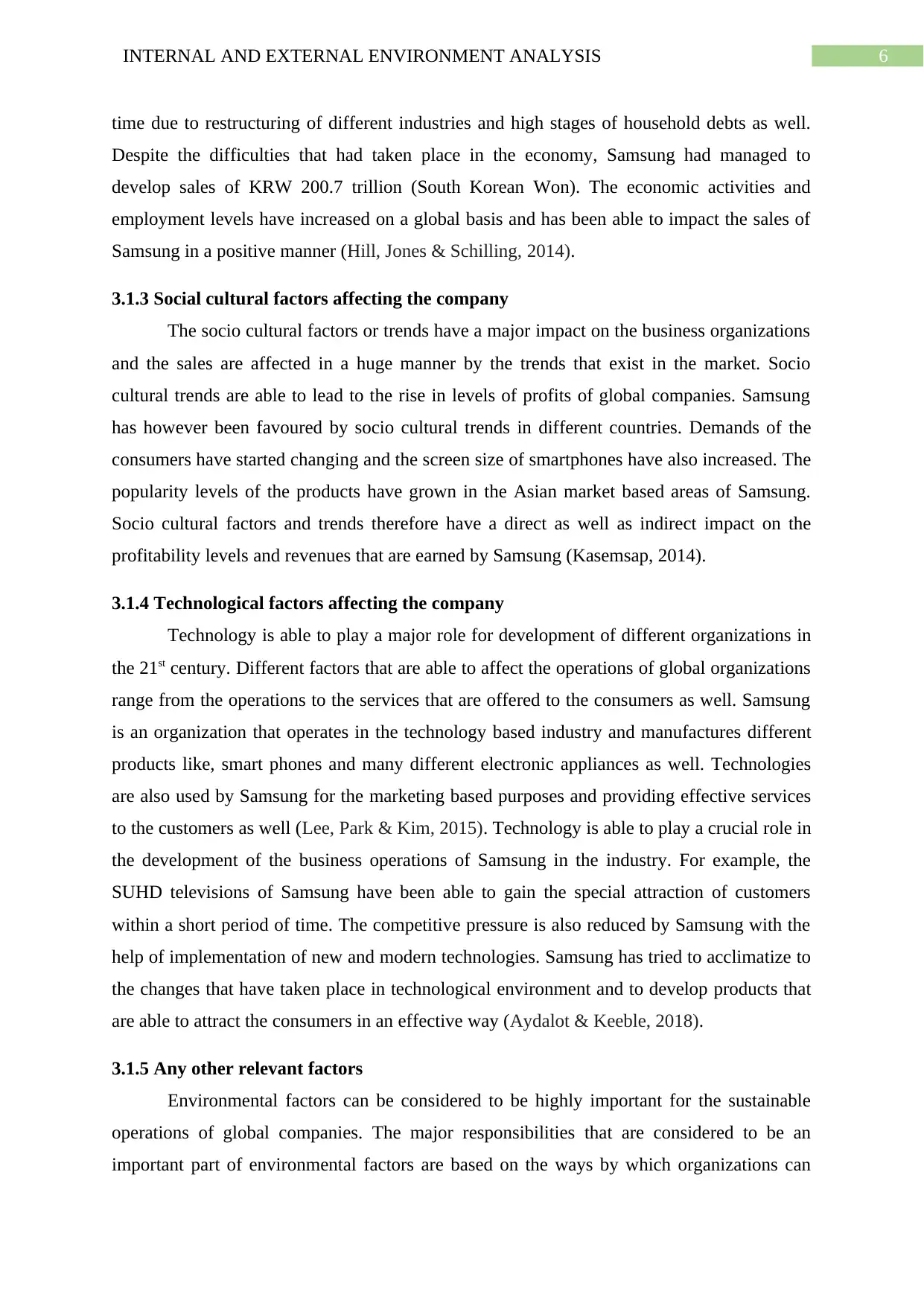
6INTERNAL AND EXTERNAL ENVIRONMENT ANALYSIS
time due to restructuring of different industries and high stages of household debts as well.
Despite the difficulties that had taken place in the economy, Samsung had managed to
develop sales of KRW 200.7 trillion (South Korean Won). The economic activities and
employment levels have increased on a global basis and has been able to impact the sales of
Samsung in a positive manner (Hill, Jones & Schilling, 2014).
3.1.3 Social cultural factors affecting the company
The socio cultural factors or trends have a major impact on the business organizations
and the sales are affected in a huge manner by the trends that exist in the market. Socio
cultural trends are able to lead to the rise in levels of profits of global companies. Samsung
has however been favoured by socio cultural trends in different countries. Demands of the
consumers have started changing and the screen size of smartphones have also increased. The
popularity levels of the products have grown in the Asian market based areas of Samsung.
Socio cultural factors and trends therefore have a direct as well as indirect impact on the
profitability levels and revenues that are earned by Samsung (Kasemsap, 2014).
3.1.4 Technological factors affecting the company
Technology is able to play a major role for development of different organizations in
the 21st century. Different factors that are able to affect the operations of global organizations
range from the operations to the services that are offered to the consumers as well. Samsung
is an organization that operates in the technology based industry and manufactures different
products like, smart phones and many different electronic appliances as well. Technologies
are also used by Samsung for the marketing based purposes and providing effective services
to the customers as well (Lee, Park & Kim, 2015). Technology is able to play a crucial role in
the development of the business operations of Samsung in the industry. For example, the
SUHD televisions of Samsung have been able to gain the special attraction of customers
within a short period of time. The competitive pressure is also reduced by Samsung with the
help of implementation of new and modern technologies. Samsung has tried to acclimatize to
the changes that have taken place in technological environment and to develop products that
are able to attract the consumers in an effective way (Aydalot & Keeble, 2018).
3.1.5 Any other relevant factors
Environmental factors can be considered to be highly important for the sustainable
operations of global companies. The major responsibilities that are considered to be an
important part of environmental factors are based on the ways by which organizations can
time due to restructuring of different industries and high stages of household debts as well.
Despite the difficulties that had taken place in the economy, Samsung had managed to
develop sales of KRW 200.7 trillion (South Korean Won). The economic activities and
employment levels have increased on a global basis and has been able to impact the sales of
Samsung in a positive manner (Hill, Jones & Schilling, 2014).
3.1.3 Social cultural factors affecting the company
The socio cultural factors or trends have a major impact on the business organizations
and the sales are affected in a huge manner by the trends that exist in the market. Socio
cultural trends are able to lead to the rise in levels of profits of global companies. Samsung
has however been favoured by socio cultural trends in different countries. Demands of the
consumers have started changing and the screen size of smartphones have also increased. The
popularity levels of the products have grown in the Asian market based areas of Samsung.
Socio cultural factors and trends therefore have a direct as well as indirect impact on the
profitability levels and revenues that are earned by Samsung (Kasemsap, 2014).
3.1.4 Technological factors affecting the company
Technology is able to play a major role for development of different organizations in
the 21st century. Different factors that are able to affect the operations of global organizations
range from the operations to the services that are offered to the consumers as well. Samsung
is an organization that operates in the technology based industry and manufactures different
products like, smart phones and many different electronic appliances as well. Technologies
are also used by Samsung for the marketing based purposes and providing effective services
to the customers as well (Lee, Park & Kim, 2015). Technology is able to play a crucial role in
the development of the business operations of Samsung in the industry. For example, the
SUHD televisions of Samsung have been able to gain the special attraction of customers
within a short period of time. The competitive pressure is also reduced by Samsung with the
help of implementation of new and modern technologies. Samsung has tried to acclimatize to
the changes that have taken place in technological environment and to develop products that
are able to attract the consumers in an effective way (Aydalot & Keeble, 2018).
3.1.5 Any other relevant factors
Environmental factors can be considered to be highly important for the sustainable
operations of global companies. The major responsibilities that are considered to be an
important part of environmental factors are based on the ways by which organizations can
Paraphrase This Document
Need a fresh take? Get an instant paraphrase of this document with our AI Paraphraser
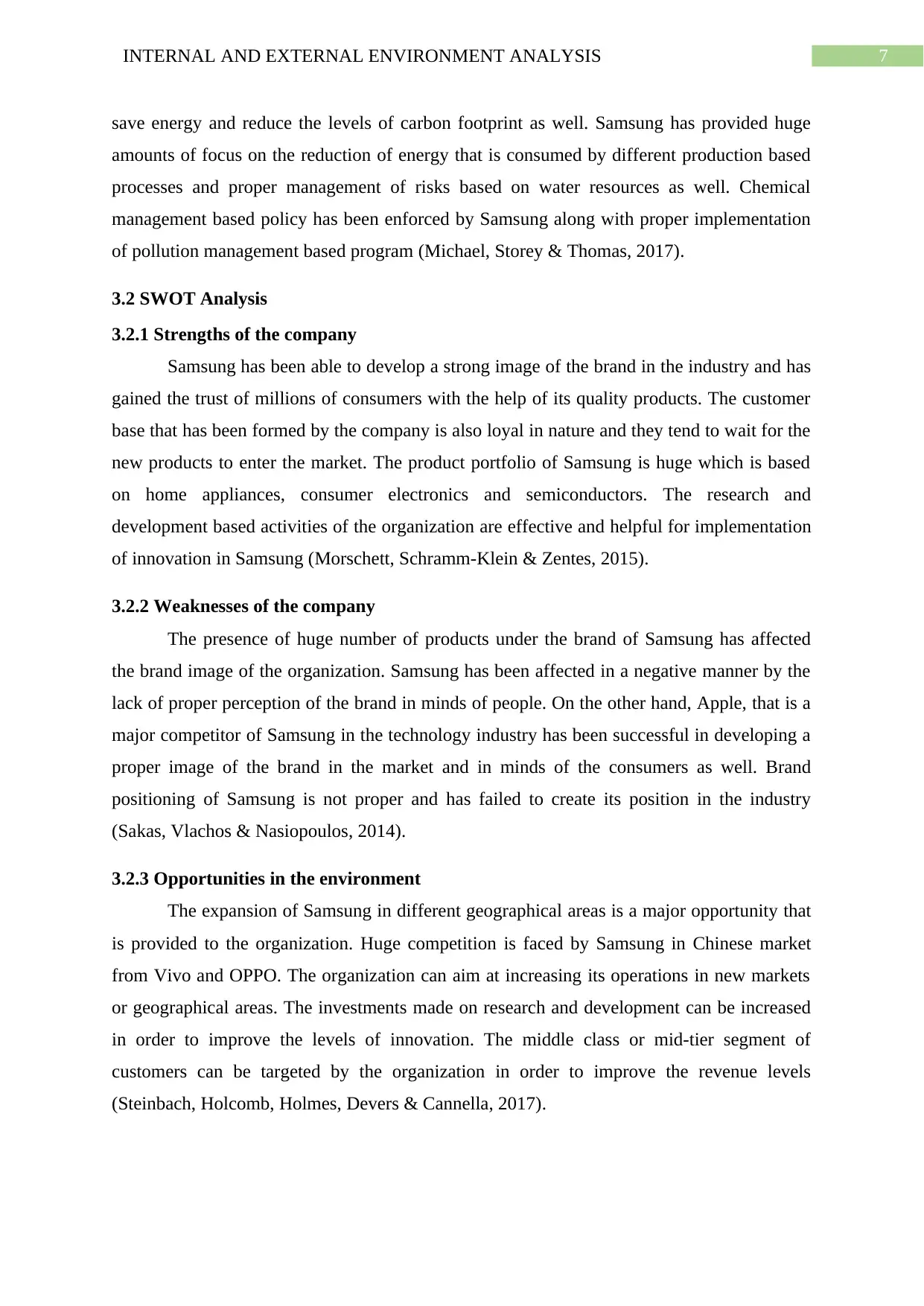
7INTERNAL AND EXTERNAL ENVIRONMENT ANALYSIS
save energy and reduce the levels of carbon footprint as well. Samsung has provided huge
amounts of focus on the reduction of energy that is consumed by different production based
processes and proper management of risks based on water resources as well. Chemical
management based policy has been enforced by Samsung along with proper implementation
of pollution management based program (Michael, Storey & Thomas, 2017).
3.2 SWOT Analysis
3.2.1 Strengths of the company
Samsung has been able to develop a strong image of the brand in the industry and has
gained the trust of millions of consumers with the help of its quality products. The customer
base that has been formed by the company is also loyal in nature and they tend to wait for the
new products to enter the market. The product portfolio of Samsung is huge which is based
on home appliances, consumer electronics and semiconductors. The research and
development based activities of the organization are effective and helpful for implementation
of innovation in Samsung (Morschett, Schramm-Klein & Zentes, 2015).
3.2.2 Weaknesses of the company
The presence of huge number of products under the brand of Samsung has affected
the brand image of the organization. Samsung has been affected in a negative manner by the
lack of proper perception of the brand in minds of people. On the other hand, Apple, that is a
major competitor of Samsung in the technology industry has been successful in developing a
proper image of the brand in the market and in minds of the consumers as well. Brand
positioning of Samsung is not proper and has failed to create its position in the industry
(Sakas, Vlachos & Nasiopoulos, 2014).
3.2.3 Opportunities in the environment
The expansion of Samsung in different geographical areas is a major opportunity that
is provided to the organization. Huge competition is faced by Samsung in Chinese market
from Vivo and OPPO. The organization can aim at increasing its operations in new markets
or geographical areas. The investments made on research and development can be increased
in order to improve the levels of innovation. The middle class or mid-tier segment of
customers can be targeted by the organization in order to improve the revenue levels
(Steinbach, Holcomb, Holmes, Devers & Cannella, 2017).
save energy and reduce the levels of carbon footprint as well. Samsung has provided huge
amounts of focus on the reduction of energy that is consumed by different production based
processes and proper management of risks based on water resources as well. Chemical
management based policy has been enforced by Samsung along with proper implementation
of pollution management based program (Michael, Storey & Thomas, 2017).
3.2 SWOT Analysis
3.2.1 Strengths of the company
Samsung has been able to develop a strong image of the brand in the industry and has
gained the trust of millions of consumers with the help of its quality products. The customer
base that has been formed by the company is also loyal in nature and they tend to wait for the
new products to enter the market. The product portfolio of Samsung is huge which is based
on home appliances, consumer electronics and semiconductors. The research and
development based activities of the organization are effective and helpful for implementation
of innovation in Samsung (Morschett, Schramm-Klein & Zentes, 2015).
3.2.2 Weaknesses of the company
The presence of huge number of products under the brand of Samsung has affected
the brand image of the organization. Samsung has been affected in a negative manner by the
lack of proper perception of the brand in minds of people. On the other hand, Apple, that is a
major competitor of Samsung in the technology industry has been successful in developing a
proper image of the brand in the market and in minds of the consumers as well. Brand
positioning of Samsung is not proper and has failed to create its position in the industry
(Sakas, Vlachos & Nasiopoulos, 2014).
3.2.3 Opportunities in the environment
The expansion of Samsung in different geographical areas is a major opportunity that
is provided to the organization. Huge competition is faced by Samsung in Chinese market
from Vivo and OPPO. The organization can aim at increasing its operations in new markets
or geographical areas. The investments made on research and development can be increased
in order to improve the levels of innovation. The middle class or mid-tier segment of
customers can be targeted by the organization in order to improve the revenue levels
(Steinbach, Holcomb, Holmes, Devers & Cannella, 2017).
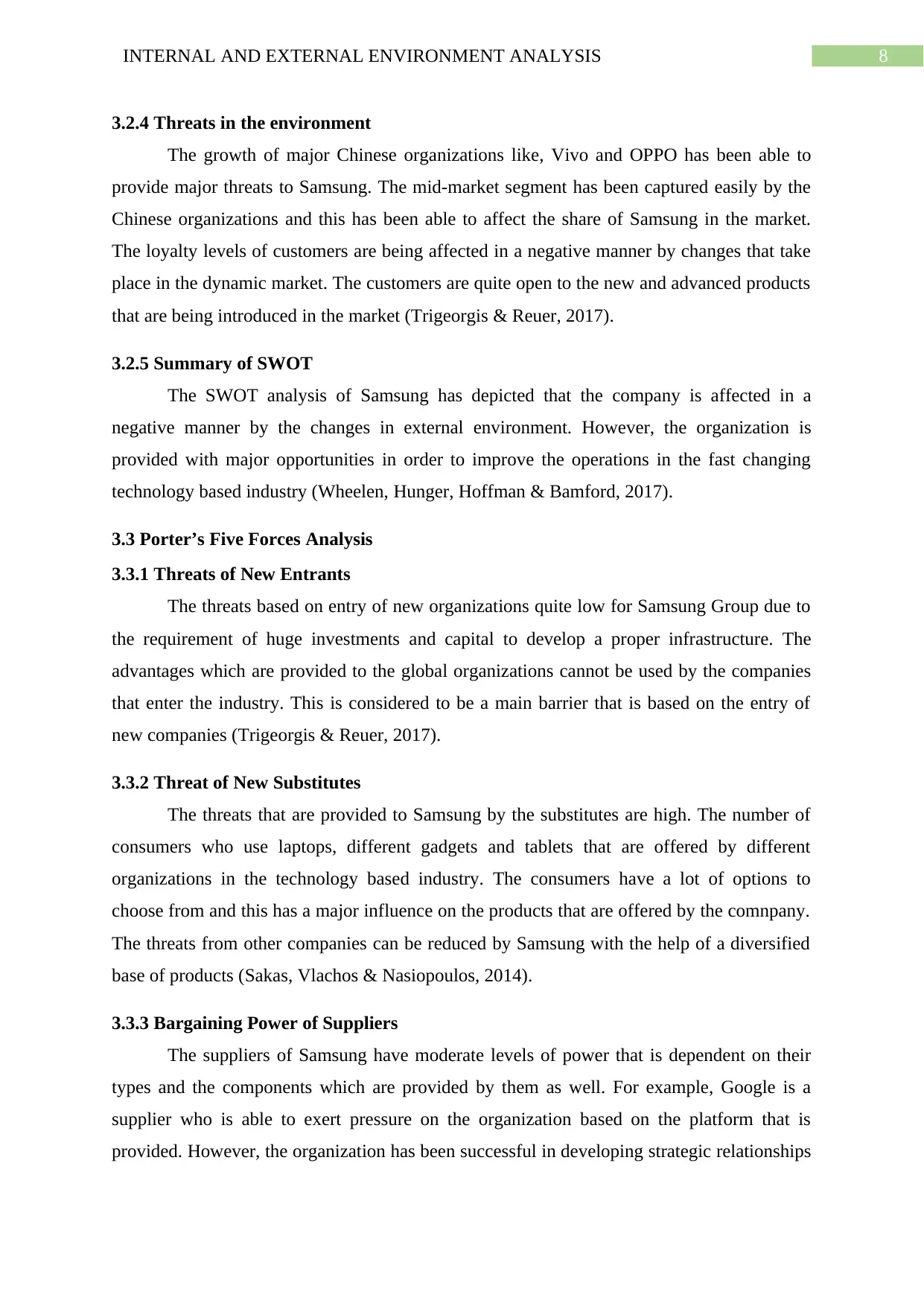
8INTERNAL AND EXTERNAL ENVIRONMENT ANALYSIS
3.2.4 Threats in the environment
The growth of major Chinese organizations like, Vivo and OPPO has been able to
provide major threats to Samsung. The mid-market segment has been captured easily by the
Chinese organizations and this has been able to affect the share of Samsung in the market.
The loyalty levels of customers are being affected in a negative manner by changes that take
place in the dynamic market. The customers are quite open to the new and advanced products
that are being introduced in the market (Trigeorgis & Reuer, 2017).
3.2.5 Summary of SWOT
The SWOT analysis of Samsung has depicted that the company is affected in a
negative manner by the changes in external environment. However, the organization is
provided with major opportunities in order to improve the operations in the fast changing
technology based industry (Wheelen, Hunger, Hoffman & Bamford, 2017).
3.3 Porter’s Five Forces Analysis
3.3.1 Threats of New Entrants
The threats based on entry of new organizations quite low for Samsung Group due to
the requirement of huge investments and capital to develop a proper infrastructure. The
advantages which are provided to the global organizations cannot be used by the companies
that enter the industry. This is considered to be a main barrier that is based on the entry of
new companies (Trigeorgis & Reuer, 2017).
3.3.2 Threat of New Substitutes
The threats that are provided to Samsung by the substitutes are high. The number of
consumers who use laptops, different gadgets and tablets that are offered by different
organizations in the technology based industry. The consumers have a lot of options to
choose from and this has a major influence on the products that are offered by the comnpany.
The threats from other companies can be reduced by Samsung with the help of a diversified
base of products (Sakas, Vlachos & Nasiopoulos, 2014).
3.3.3 Bargaining Power of Suppliers
The suppliers of Samsung have moderate levels of power that is dependent on their
types and the components which are provided by them as well. For example, Google is a
supplier who is able to exert pressure on the organization based on the platform that is
provided. However, the organization has been successful in developing strategic relationships
3.2.4 Threats in the environment
The growth of major Chinese organizations like, Vivo and OPPO has been able to
provide major threats to Samsung. The mid-market segment has been captured easily by the
Chinese organizations and this has been able to affect the share of Samsung in the market.
The loyalty levels of customers are being affected in a negative manner by changes that take
place in the dynamic market. The customers are quite open to the new and advanced products
that are being introduced in the market (Trigeorgis & Reuer, 2017).
3.2.5 Summary of SWOT
The SWOT analysis of Samsung has depicted that the company is affected in a
negative manner by the changes in external environment. However, the organization is
provided with major opportunities in order to improve the operations in the fast changing
technology based industry (Wheelen, Hunger, Hoffman & Bamford, 2017).
3.3 Porter’s Five Forces Analysis
3.3.1 Threats of New Entrants
The threats based on entry of new organizations quite low for Samsung Group due to
the requirement of huge investments and capital to develop a proper infrastructure. The
advantages which are provided to the global organizations cannot be used by the companies
that enter the industry. This is considered to be a main barrier that is based on the entry of
new companies (Trigeorgis & Reuer, 2017).
3.3.2 Threat of New Substitutes
The threats that are provided to Samsung by the substitutes are high. The number of
consumers who use laptops, different gadgets and tablets that are offered by different
organizations in the technology based industry. The consumers have a lot of options to
choose from and this has a major influence on the products that are offered by the comnpany.
The threats from other companies can be reduced by Samsung with the help of a diversified
base of products (Sakas, Vlachos & Nasiopoulos, 2014).
3.3.3 Bargaining Power of Suppliers
The suppliers of Samsung have moderate levels of power that is dependent on their
types and the components which are provided by them as well. For example, Google is a
supplier who is able to exert pressure on the organization based on the platform that is
provided. However, the organization has been successful in developing strategic relationships
⊘ This is a preview!⊘
Do you want full access?
Subscribe today to unlock all pages.

Trusted by 1+ million students worldwide
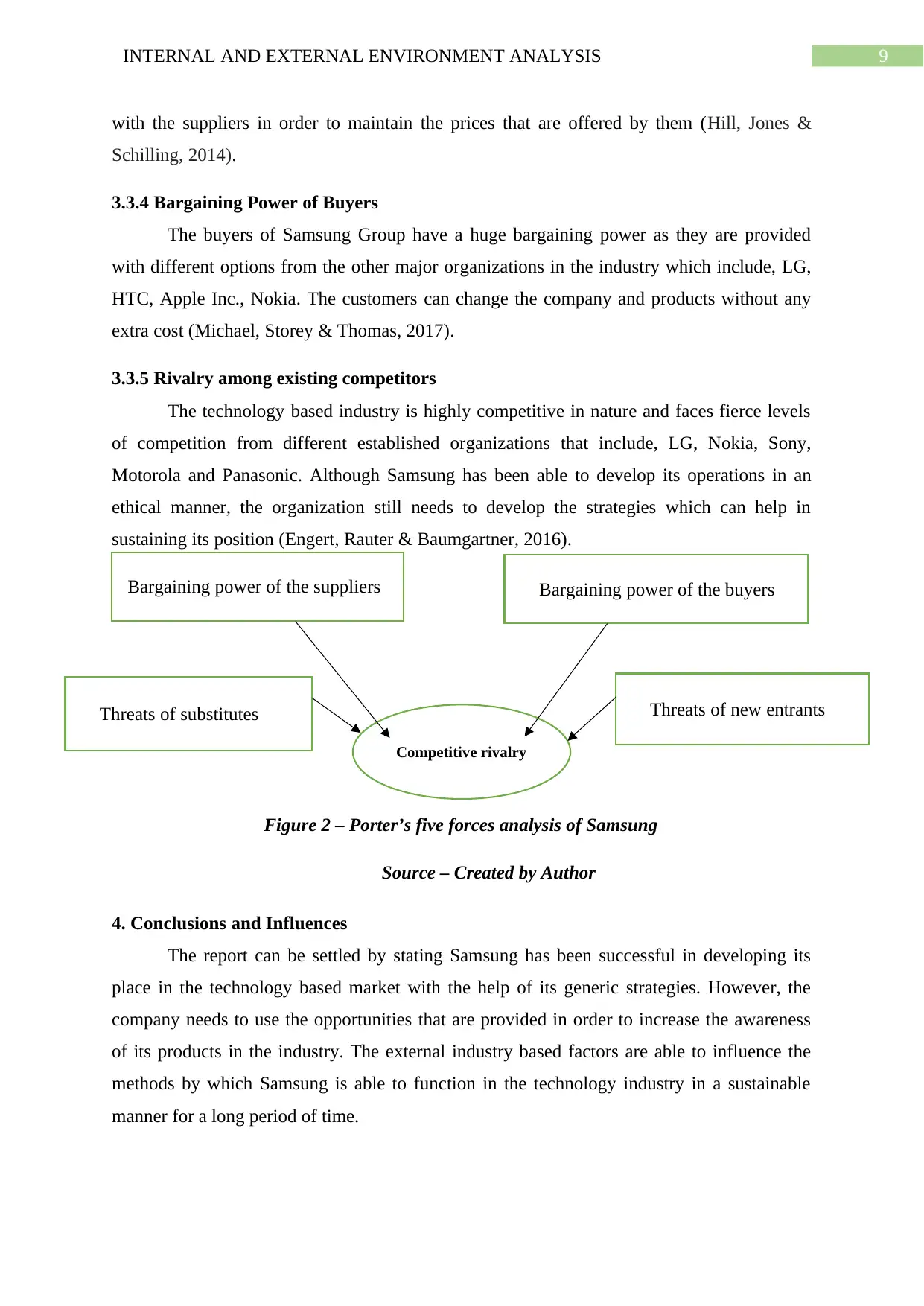
9INTERNAL AND EXTERNAL ENVIRONMENT ANALYSIS
with the suppliers in order to maintain the prices that are offered by them (Hill, Jones &
Schilling, 2014).
3.3.4 Bargaining Power of Buyers
The buyers of Samsung Group have a huge bargaining power as they are provided
with different options from the other major organizations in the industry which include, LG,
HTC, Apple Inc., Nokia. The customers can change the company and products without any
extra cost (Michael, Storey & Thomas, 2017).
3.3.5 Rivalry among existing competitors
The technology based industry is highly competitive in nature and faces fierce levels
of competition from different established organizations that include, LG, Nokia, Sony,
Motorola and Panasonic. Although Samsung has been able to develop its operations in an
ethical manner, the organization still needs to develop the strategies which can help in
sustaining its position (Engert, Rauter & Baumgartner, 2016).
Figure 2 – Porter’s five forces analysis of Samsung
Source – Created by Author
4. Conclusions and Influences
The report can be settled by stating Samsung has been successful in developing its
place in the technology based market with the help of its generic strategies. However, the
company needs to use the opportunities that are provided in order to increase the awareness
of its products in the industry. The external industry based factors are able to influence the
methods by which Samsung is able to function in the technology industry in a sustainable
manner for a long period of time.
Bargaining power of the suppliers
Threats of substitutes
Bargaining power of the buyers
Threats of new entrants
Competitive rivalry
with the suppliers in order to maintain the prices that are offered by them (Hill, Jones &
Schilling, 2014).
3.3.4 Bargaining Power of Buyers
The buyers of Samsung Group have a huge bargaining power as they are provided
with different options from the other major organizations in the industry which include, LG,
HTC, Apple Inc., Nokia. The customers can change the company and products without any
extra cost (Michael, Storey & Thomas, 2017).
3.3.5 Rivalry among existing competitors
The technology based industry is highly competitive in nature and faces fierce levels
of competition from different established organizations that include, LG, Nokia, Sony,
Motorola and Panasonic. Although Samsung has been able to develop its operations in an
ethical manner, the organization still needs to develop the strategies which can help in
sustaining its position (Engert, Rauter & Baumgartner, 2016).
Figure 2 – Porter’s five forces analysis of Samsung
Source – Created by Author
4. Conclusions and Influences
The report can be settled by stating Samsung has been successful in developing its
place in the technology based market with the help of its generic strategies. However, the
company needs to use the opportunities that are provided in order to increase the awareness
of its products in the industry. The external industry based factors are able to influence the
methods by which Samsung is able to function in the technology industry in a sustainable
manner for a long period of time.
Bargaining power of the suppliers
Threats of substitutes
Bargaining power of the buyers
Threats of new entrants
Competitive rivalry
Paraphrase This Document
Need a fresh take? Get an instant paraphrase of this document with our AI Paraphraser
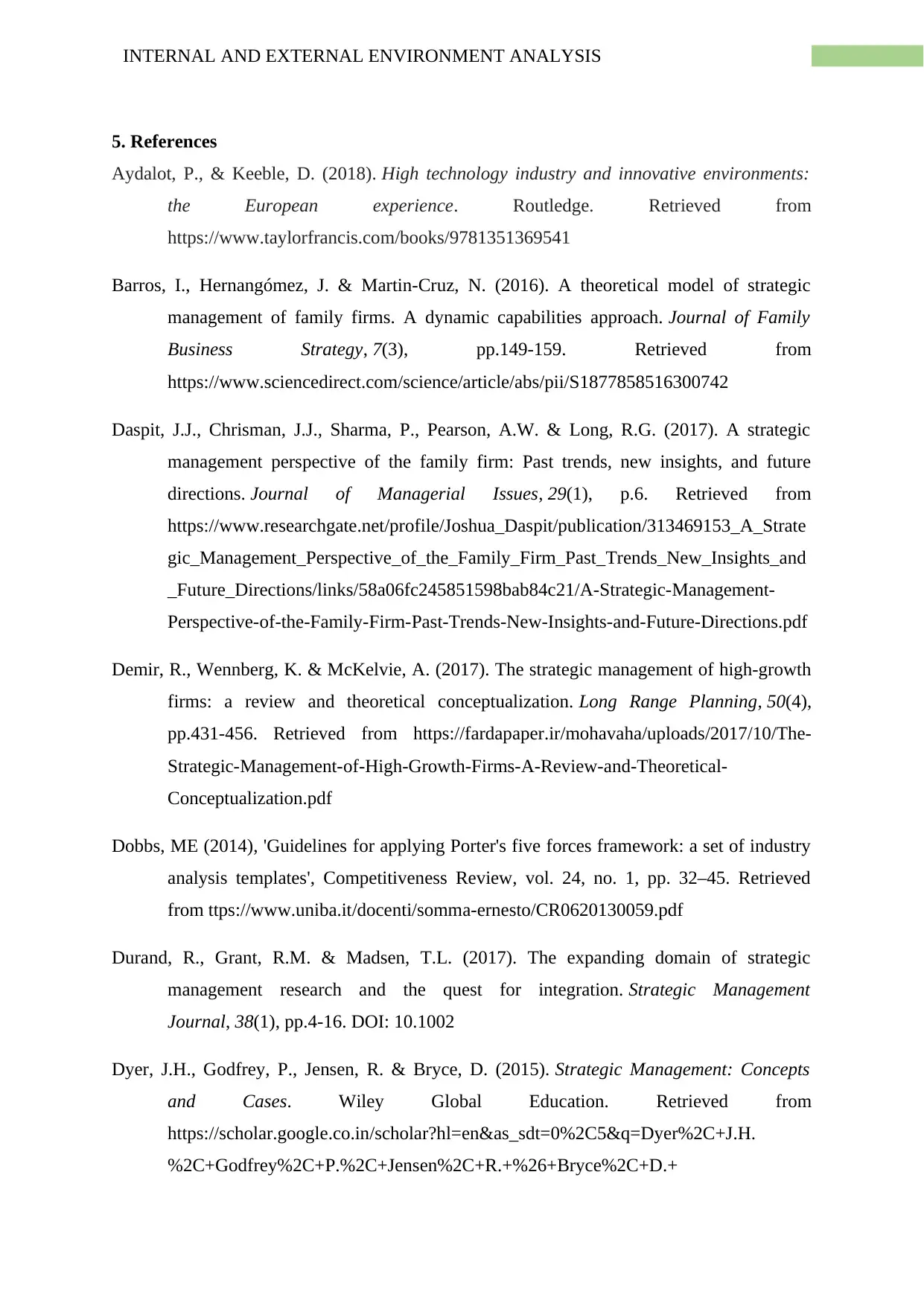
10INTERNAL AND EXTERNAL ENVIRONMENT ANALYSIS
5. References
Aydalot, P., & Keeble, D. (2018). High technology industry and innovative environments:
the European experience. Routledge. Retrieved from
https://www.taylorfrancis.com/books/9781351369541
Barros, I., Hernangómez, J. & Martin-Cruz, N. (2016). A theoretical model of strategic
management of family firms. A dynamic capabilities approach. Journal of Family
Business Strategy, 7(3), pp.149-159. Retrieved from
https://www.sciencedirect.com/science/article/abs/pii/S1877858516300742
Daspit, J.J., Chrisman, J.J., Sharma, P., Pearson, A.W. & Long, R.G. (2017). A strategic
management perspective of the family firm: Past trends, new insights, and future
directions. Journal of Managerial Issues, 29(1), p.6. Retrieved from
https://www.researchgate.net/profile/Joshua_Daspit/publication/313469153_A_Strate
gic_Management_Perspective_of_the_Family_Firm_Past_Trends_New_Insights_and
_Future_Directions/links/58a06fc245851598bab84c21/A-Strategic-Management-
Perspective-of-the-Family-Firm-Past-Trends-New-Insights-and-Future-Directions.pdf
Demir, R., Wennberg, K. & McKelvie, A. (2017). The strategic management of high-growth
firms: a review and theoretical conceptualization. Long Range Planning, 50(4),
pp.431-456. Retrieved from https://fardapaper.ir/mohavaha/uploads/2017/10/The-
Strategic-Management-of-High-Growth-Firms-A-Review-and-Theoretical-
Conceptualization.pdf
Dobbs, ME (2014), 'Guidelines for applying Porter's five forces framework: a set of industry
analysis templates', Competitiveness Review, vol. 24, no. 1, pp. 32–45. Retrieved
from ttps://www.uniba.it/docenti/somma-ernesto/CR0620130059.pdf
Durand, R., Grant, R.M. & Madsen, T.L. (2017). The expanding domain of strategic
management research and the quest for integration. Strategic Management
Journal, 38(1), pp.4-16. DOI: 10.1002
Dyer, J.H., Godfrey, P., Jensen, R. & Bryce, D. (2015). Strategic Management: Concepts
and Cases. Wiley Global Education. Retrieved from
https://scholar.google.co.in/scholar?hl=en&as_sdt=0%2C5&q=Dyer%2C+J.H.
%2C+Godfrey%2C+P.%2C+Jensen%2C+R.+%26+Bryce%2C+D.+
5. References
Aydalot, P., & Keeble, D. (2018). High technology industry and innovative environments:
the European experience. Routledge. Retrieved from
https://www.taylorfrancis.com/books/9781351369541
Barros, I., Hernangómez, J. & Martin-Cruz, N. (2016). A theoretical model of strategic
management of family firms. A dynamic capabilities approach. Journal of Family
Business Strategy, 7(3), pp.149-159. Retrieved from
https://www.sciencedirect.com/science/article/abs/pii/S1877858516300742
Daspit, J.J., Chrisman, J.J., Sharma, P., Pearson, A.W. & Long, R.G. (2017). A strategic
management perspective of the family firm: Past trends, new insights, and future
directions. Journal of Managerial Issues, 29(1), p.6. Retrieved from
https://www.researchgate.net/profile/Joshua_Daspit/publication/313469153_A_Strate
gic_Management_Perspective_of_the_Family_Firm_Past_Trends_New_Insights_and
_Future_Directions/links/58a06fc245851598bab84c21/A-Strategic-Management-
Perspective-of-the-Family-Firm-Past-Trends-New-Insights-and-Future-Directions.pdf
Demir, R., Wennberg, K. & McKelvie, A. (2017). The strategic management of high-growth
firms: a review and theoretical conceptualization. Long Range Planning, 50(4),
pp.431-456. Retrieved from https://fardapaper.ir/mohavaha/uploads/2017/10/The-
Strategic-Management-of-High-Growth-Firms-A-Review-and-Theoretical-
Conceptualization.pdf
Dobbs, ME (2014), 'Guidelines for applying Porter's five forces framework: a set of industry
analysis templates', Competitiveness Review, vol. 24, no. 1, pp. 32–45. Retrieved
from ttps://www.uniba.it/docenti/somma-ernesto/CR0620130059.pdf
Durand, R., Grant, R.M. & Madsen, T.L. (2017). The expanding domain of strategic
management research and the quest for integration. Strategic Management
Journal, 38(1), pp.4-16. DOI: 10.1002
Dyer, J.H., Godfrey, P., Jensen, R. & Bryce, D. (2015). Strategic Management: Concepts
and Cases. Wiley Global Education. Retrieved from
https://scholar.google.co.in/scholar?hl=en&as_sdt=0%2C5&q=Dyer%2C+J.H.
%2C+Godfrey%2C+P.%2C+Jensen%2C+R.+%26+Bryce%2C+D.+
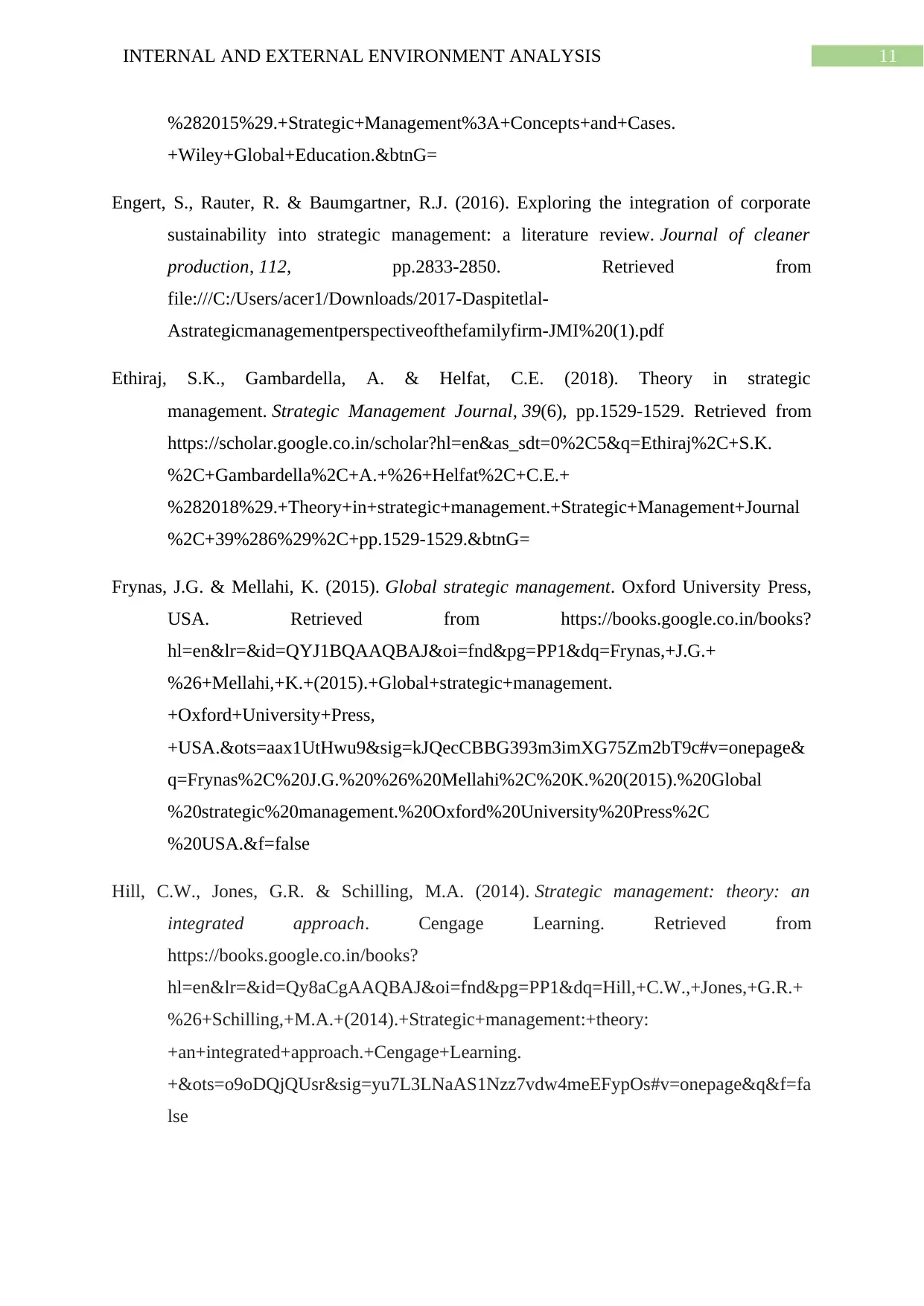
11INTERNAL AND EXTERNAL ENVIRONMENT ANALYSIS
%282015%29.+Strategic+Management%3A+Concepts+and+Cases.
+Wiley+Global+Education.&btnG=
Engert, S., Rauter, R. & Baumgartner, R.J. (2016). Exploring the integration of corporate
sustainability into strategic management: a literature review. Journal of cleaner
production, 112, pp.2833-2850. Retrieved from
file:///C:/Users/acer1/Downloads/2017-Daspitetlal-
Astrategicmanagementperspectiveofthefamilyfirm-JMI%20(1).pdf
Ethiraj, S.K., Gambardella, A. & Helfat, C.E. (2018). Theory in strategic
management. Strategic Management Journal, 39(6), pp.1529-1529. Retrieved from
https://scholar.google.co.in/scholar?hl=en&as_sdt=0%2C5&q=Ethiraj%2C+S.K.
%2C+Gambardella%2C+A.+%26+Helfat%2C+C.E.+
%282018%29.+Theory+in+strategic+management.+Strategic+Management+Journal
%2C+39%286%29%2C+pp.1529-1529.&btnG=
Frynas, J.G. & Mellahi, K. (2015). Global strategic management. Oxford University Press,
USA. Retrieved from https://books.google.co.in/books?
hl=en&lr=&id=QYJ1BQAAQBAJ&oi=fnd&pg=PP1&dq=Frynas,+J.G.+
%26+Mellahi,+K.+(2015).+Global+strategic+management.
+Oxford+University+Press,
+USA.&ots=aax1UtHwu9&sig=kJQecCBBG393m3imXG75Zm2bT9c#v=onepage&
q=Frynas%2C%20J.G.%20%26%20Mellahi%2C%20K.%20(2015).%20Global
%20strategic%20management.%20Oxford%20University%20Press%2C
%20USA.&f=false
Hill, C.W., Jones, G.R. & Schilling, M.A. (2014). Strategic management: theory: an
integrated approach. Cengage Learning. Retrieved from
https://books.google.co.in/books?
hl=en&lr=&id=Qy8aCgAAQBAJ&oi=fnd&pg=PP1&dq=Hill,+C.W.,+Jones,+G.R.+
%26+Schilling,+M.A.+(2014).+Strategic+management:+theory:
+an+integrated+approach.+Cengage+Learning.
+&ots=o9oDQjQUsr&sig=yu7L3LNaAS1Nzz7vdw4meEFypOs#v=onepage&q&f=fa
lse
%282015%29.+Strategic+Management%3A+Concepts+and+Cases.
+Wiley+Global+Education.&btnG=
Engert, S., Rauter, R. & Baumgartner, R.J. (2016). Exploring the integration of corporate
sustainability into strategic management: a literature review. Journal of cleaner
production, 112, pp.2833-2850. Retrieved from
file:///C:/Users/acer1/Downloads/2017-Daspitetlal-
Astrategicmanagementperspectiveofthefamilyfirm-JMI%20(1).pdf
Ethiraj, S.K., Gambardella, A. & Helfat, C.E. (2018). Theory in strategic
management. Strategic Management Journal, 39(6), pp.1529-1529. Retrieved from
https://scholar.google.co.in/scholar?hl=en&as_sdt=0%2C5&q=Ethiraj%2C+S.K.
%2C+Gambardella%2C+A.+%26+Helfat%2C+C.E.+
%282018%29.+Theory+in+strategic+management.+Strategic+Management+Journal
%2C+39%286%29%2C+pp.1529-1529.&btnG=
Frynas, J.G. & Mellahi, K. (2015). Global strategic management. Oxford University Press,
USA. Retrieved from https://books.google.co.in/books?
hl=en&lr=&id=QYJ1BQAAQBAJ&oi=fnd&pg=PP1&dq=Frynas,+J.G.+
%26+Mellahi,+K.+(2015).+Global+strategic+management.
+Oxford+University+Press,
+USA.&ots=aax1UtHwu9&sig=kJQecCBBG393m3imXG75Zm2bT9c#v=onepage&
q=Frynas%2C%20J.G.%20%26%20Mellahi%2C%20K.%20(2015).%20Global
%20strategic%20management.%20Oxford%20University%20Press%2C
%20USA.&f=false
Hill, C.W., Jones, G.R. & Schilling, M.A. (2014). Strategic management: theory: an
integrated approach. Cengage Learning. Retrieved from
https://books.google.co.in/books?
hl=en&lr=&id=Qy8aCgAAQBAJ&oi=fnd&pg=PP1&dq=Hill,+C.W.,+Jones,+G.R.+
%26+Schilling,+M.A.+(2014).+Strategic+management:+theory:
+an+integrated+approach.+Cengage+Learning.
+&ots=o9oDQjQUsr&sig=yu7L3LNaAS1Nzz7vdw4meEFypOs#v=onepage&q&f=fa
lse
⊘ This is a preview!⊘
Do you want full access?
Subscribe today to unlock all pages.

Trusted by 1+ million students worldwide
1 out of 15
Related Documents
Your All-in-One AI-Powered Toolkit for Academic Success.
+13062052269
info@desklib.com
Available 24*7 on WhatsApp / Email
![[object Object]](/_next/static/media/star-bottom.7253800d.svg)
Unlock your academic potential
Copyright © 2020–2025 A2Z Services. All Rights Reserved. Developed and managed by ZUCOL.





